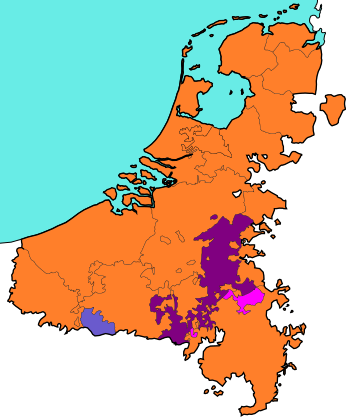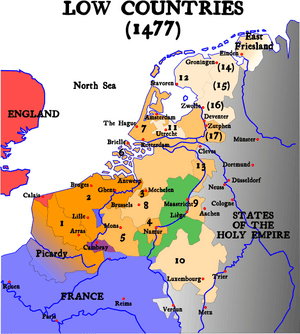Habsburg Netherlands facts for kids
Quick facts for kids
Habsburg Netherlands
|
|||||||||||||
|---|---|---|---|---|---|---|---|---|---|---|---|---|---|
| 1482–1797 | |||||||||||||
|
|
|||||||||||||

|
|||||||||||||
| Status | Personal union of Imperial fiefs within Empire | ||||||||||||
| Capital | De facto: Mechelen till 1530, afterwards Brussels | ||||||||||||
| Common languages | Dutch, Low Saxon, West Frisian, Walloon, Luxembourgish, French | ||||||||||||
| Religion |
|
||||||||||||
| Government | Monarchy | ||||||||||||
| Historical era | Early modern period | ||||||||||||
|
• Inherited by House of Habsburg
|
1482 | ||||||||||||
|
• Incorporated into Burgundian Circle
|
1512 | ||||||||||||
|
• Pragmatic Sanction
|
1549 | ||||||||||||
|
• Inherited by Habsburg Spain
|
1556 | ||||||||||||
| 30 January 1648 | |||||||||||||
| 7 March 1714 | |||||||||||||
|
• Battle of Sprimont
|
18 September 1794 | ||||||||||||
| 17 October 1797 | |||||||||||||
| ISO 3166 code | NL | ||||||||||||
|
|||||||||||||
The Habsburg Netherlands was a group of territories in the Low Countries (modern-day Netherlands, Belgium, and Luxembourg). These lands were ruled by the powerful House of Habsburg, a royal family from the Holy Roman Empire. Their rule began in 1482.
This happened when Mary of Burgundy, the last ruler from the Valois-Burgundy family, passed away. She was married to Maximilian I of Austria from the Habsburg family. Their grandson, Emperor Charles V, was born in the Habsburg Netherlands. He even made Brussels one of his main cities.
By 1549, these territories became known as the Seventeen Provinces. From 1556, the Spanish branch of the Habsburg family took control. These lands were then called the Spanish Netherlands. In 1581, during the Dutch Revolt, seven northern provinces broke away. They formed their own country, the Dutch Republic.
The remaining southern parts became the Austrian Netherlands in 1714. This happened after Austria gained them through the Treaty of Rastatt. The Habsburg rule mostly ended in 1795 when France took over. Austria officially gave up its claim in 1797 with the Treaty of Campo Formio.
Contents
Geography of the Low Countries
The Habsburg Netherlands covered the entire Low Countries region. This area includes what is now the Netherlands, Belgium, Luxembourg, and parts of northern France.
The northern Low Countries started to grow around 1200 CE. People drained land and built flood controls, making more land available for farming. The population increased, and the region of Holland became very important. Before this, large cities were mainly in the south. Cities like Ghent, Bruges, Antwerp, Brussels, and Leuven were bigger than any northern settlements.
Rivers in the Low Countries flow from east to west. These rivers acted as natural barriers. They made it hard for southern influences to reach the north. This led to the formation of two separate political areas.
How the Provinces United
Before the Habsburgs, the Low Countries were ruled by the Burgundian dukes. Under Duke Philip the Good (1419–1467), the different provinces began to unite. Before this, some were linked to the French Kingdom, and others to Burgundy under the Holy Roman Empire.
The main territories included Flanders, Artois, Mechelen, Namur, Holland, Zeeland, Hainaut, Brabant, Limburg, and Luxembourg. These areas were ruled together by the Valois-Burgundy monarchs. They were all represented in a meeting called the States-General of the Netherlands. The main center of the Burgundian lands was the Duchy of Brabant, where the dukes had their court in Brussels.
Philip's son, Duke Charles the Bold (1467–1477), added Guelders and Zutphen to his lands. He even hoped to become a king. He wanted to marry his daughter Mary to Maximilian, a Habsburg prince. However, Charles faced a series of wars called the Burgundian Wars. He was killed in the Battle of Nancy, which was a big loss.
History of Habsburg Rule
| History of the Low Countries | ||||||||
|---|---|---|---|---|---|---|---|---|
| Frisii | Belgae | |||||||
| Cana- nefates |
Chamavi, Tubantes |
Gallia Belgica (55 BC – 5th c. AD) Germania Inferior (83 – 5th c.) |
||||||
| Salian Franks | Batavi | |||||||
| unpopulated (4th–5th c.) |
Saxons | Salian Franks (4th–5th c.) |
||||||
| Frisian Kingdom (6th c.–734) |
Frankish Kingdom (481–843)—Carolingian Empire (800–843) | |||||||
| Austrasia (511–687) | ||||||||
| Middle Francia (843–855) | West Francia (843–) |
|||||||
| Kingdom of Lotharingia (855– 959) Duchy of Lower Lorraine (959–) |
||||||||
| Frisia | ||||||||
Frisian Freedom (11–16th century) |
County of Holland (880–1432) |
Bishopric of Utrecht (695–1456) |
Duchy of Brabant (1183–1430) Duchy of Guelders (1046–1543) |
County of Flanders (862–1384) |
County of Hainaut (1071–1432) County of Namur (981–1421) |
P.-Bish. of Liège (980–1794) |
Duchy of Luxem- bourg (1059–1443) |
|
Burgundian Netherlands (1384–1482) |
||||||||
Habsburg Netherlands (1482–1795) (Seventeen Provinces after 1543) |
||||||||
Dutch Republic (1581–1795) |
Spanish Netherlands (1556–1714) |
|||||||
Austrian Netherlands (1714–1795) |
||||||||
United States of Belgium (1790) |
R. Liège (1789–'91) |
|||||||
Batavian Republic (1795–1806) Kingdom of Holland (1806–1810) |
associated with French First Republic (1795–1804) part of First French Empire (1804–1815) |
|||||||
Princip. of the Netherlands (1813–1815) |
||||||||
| United Kingdom of the Netherlands (1815–1830) | Gr D. L. (1815–) |
|||||||
Kingdom of the Netherlands (1839–) |
Kingdom of Belgium (1830–) |
|||||||
| Gr D. of Luxem- bourg (1890–) |
||||||||
When Mary of Burgundy died in 1482, her lands, including the Burgundian Netherlands, went to her son, Philip I of Castile. Philip was also known as Philip the Handsome. He married Joanna of Castile, whose parents were the famous Catholic Monarchs of Spain.
Philip's father was Maximilian I, Holy Roman Emperor. Because of this family connection, Philip was a member of the Habsburg family. This is how the period of the Habsburg Netherlands began. From 1481 to 1492, there were revolts in the Flemish cities. There was also a civil war in Utrecht. But by the early 1500s, the Austrian rulers had brought peace to both areas.
Charles V's Reign
Philip's son, Charles, was born in Ghent. He became ruler in 1506 when he was only six years old. His grandfather, Emperor Maximilian I, made the Burgundian lands part of the Burgundian Circle. This gave the territories in the far west of the Empire some independence.
Through his mother, Joanna of Castile, Charles also inherited the kingdoms of Spain and their vast overseas empire. Charles took full control in 1515. He ruled his Burgundian lands as someone who truly belonged to the Netherlands. He gained more lands, including Overijssel and the Prince-Bishopric of Utrecht. He also bought Friesland and regained Groningen and Gelderland.
His territories, now known as the Seventeen Provinces, were reorganized in 1548. This agreement, called the 1548 Burgundian Treaty, gave the Netherlands more self-rule within the Empire. The next year, Emperor Charles issued a special law. This law made the Seventeen Provinces a single unit, separate from the Empire and from France.
Division and Revolt
Between 1555 and 1556, Charles V decided to give up his power. He split the House of Habsburg into two branches: an Austrian-German branch and a Spanish branch. His brother Ferdinand I became the ruler of Austria, Bohemia, and Hungary. He also became the new Holy Roman Emperor.
Philip II of Spain, Charles's son, inherited the Seventeen Provinces. These lands became part of the Monarchy of Spain. Philip II became known for his strict rule and his persecution of Protestants. This led to the Dutch Revolt and the Eighty Years' War. Spain's control over the northern provinces became weaker and weaker.
In 1579, the northern provinces formed the Protestant Union of Utrecht. In 1581, they declared their independence from Spain. This was done through a document called the Act of Abjuration. These seven provinces then became the Dutch Republic.
After 1581, the southern provinces remained under Habsburg rule. These areas included Flanders, Artois, Luxembourg, Limburg, Hainaut, Namur, Mechelen, and Brabant. They stayed with the Habsburg family until the French Revolutionary Wars. After the Spanish Habsburg family ended in 1700, the southern provinces became known as the Austrian Netherlands from 1715 onwards.
Rulers of the Habsburg Netherlands
The Habsburg Netherlands was ruled by several important figures. Here are the main rulers:
- 1482–1506: Philip I of Castile (also known as Philip the Handsome). His father, Maximilian I, was regent (ruled for him) from 1482–1493.
- 1506–1556: Charles V. He became Holy Roman Emperor in 1519.
- 1556–1581: Philip II. He was also the King of Spain.
These rulers often appointed a special governor to manage the provinces for them. These governors were called stadtholders or landvoogd. Here are some of the key governors:
- 1489–1493: Margaret of York, who was the step-grandmother of Philip I.
- 1506–1507: William de Croÿ, Marquis d'Aerschot.
- 1507–1530: Margaret of Austria, Duchess of Savoy.
- 1531–1555: Mary of Hungary.
- 1555–1559: Emmanuel Philibert, Duke of Savoy.
- 1559–1567: Margaret of Parma.
- 1567–1573: Fernando Álvarez de Toledo, 3rd Duke of Alba.
- 1573–1576: Luis de Requesens y Zúñiga.
- 1576–1578: John of Austria.
- 1578–1592: Alexander Farnese, Duke of Parma.
In 1578, the Dutch rebels tried to appoint Archduke Matthias of Austria as governor. However, he could not gain full control and resigned before the Act of Abjuration in 1581.
See also
 In Spanish: Países Bajos de los Habsburgo para niños
In Spanish: Países Bajos de los Habsburgo para niños




